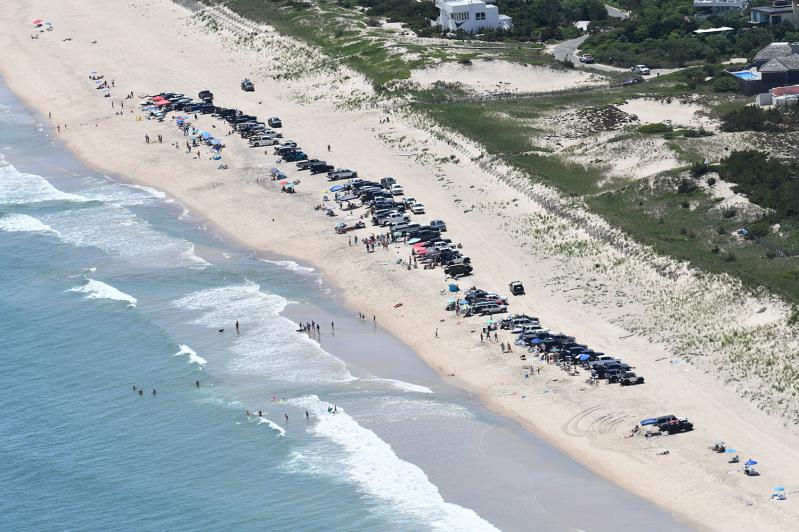East Hampton Town officials are enforcing a prohibition of vehicles on a 4,000-foot stretch of ocean beach on Napeague popularly known as Truck Beach, following Friday's injunction issued by the New York State Supreme Court Appellate Division reiterating its February affirmation that the property owners do, in fact, own the beach and that residents have no inherent right to drive or park vehicles there.
Ownership of the beach is at the heart of a dozen-year legal battle pitting property owners landward of the beach against town residents who have driven and parked on and otherwise enjoyed that stretch of beach for generations.
The injunction names as defendants the five members of the town board, the nine town trustees, East Hampton Town Police Chief Michael Sarlo, and Ed Michels, the chief harbormaster, threatening them with civil contempt should they violate the Feb. 3 decision that the homeowners associations' chains of title to their respective properties extend to the mean high-water mark of the ocean. It came in response to an application by James Catterson, an attorney representing one of the homeowners associations, to hold the town in civil contempt for failing to prohibit vehicular access to the beach. The defendants are to appear in State Supreme Court in Riverhead next Thursday.
The town, according to Friday's injunction, must comply with the Feb. 3 ruling and revoke "any and all permits issued by the town for the 2021 season that do not expressly prohibit driving or parking on the beach in question."
In the Feb. 3 decision, a panel of four Appellate Division judges reversed much of a 2016 State Supreme Court decision ruling that an 1882 deed in which the trustees conveyed some 1,000 acres on Napeague to Arthur Benson "clearly reserved some rights 'to the inhabitants of East Hampton' and, arguably, the allowances for some public use."
It's unusual for enforcement to try to enforce private parking violations. — East Hampton Town Supervisor Peter Van Scoyoc
The Appellate Division judges came to a starkly different conclusion in February, writing that, contrary to the Supreme Court's determination, the homeowners associations "established their title claims by a preponderance of the evidence." The trustees, they wrote, had conveyed title to the disputed portion of the beach to Benson, "the homeowners associations' common predecessor-in-interest."
The town and trustees contended that even if the homeowners associations established their title claims, the town nonetheless retained the right to allow the public to operate and park vehicles along the beach, including the portion owned by the homeowners associations, based on a reservation in the Benson deed, the panel wrote. "Specif-ically, the clause at issue 'reserved to the inhabitants of the Town of East Hampton the right to land fish boats and netts [sic] to spread the netts [sic] on the adjacent sands and care for the fish and material as has been customary heretofore on the South Shore of the Town lying westerly of these conveyed premises.' "
But that reservation cannot be construed as broadly as the town and trustees contend, they wrote. Rather, it is akin to "an easement allowing the public to use the homeowners associations' portion of the beach only for fishing and fishing-related purposes" and not authority to issue permits allowing the public to drive and park on any portion of the beach owned by the homeowners associations.
"We are in a situation where we need to seek further clarification from the judge in the case as to what exactly we will be enforcing," Supervisor Peter Van Scoyoc said on Tuesday. "It's unusual for enforcement to try to enforce private parking violations." Until such clarification, he said, "we are asking people not to drive at this section of beach."
Expressing his personal opinion, Mr. Van Scoyoc said that "we need to take every step necessary to ensure our traditional beach access rights, no matter where they are within the township. . . . In the interim, I'm asking you to be patient and comply" until the next steps are determined.
That is "a step," Stephen Angel, an attorney representing four of the property owners' associations, said on Tuesday. But "what the town has to realize is that for the last 20 to 30 years they've been directing people to park on our clients' properties over their objection."
Driving on the beach in question had historically been allowed, even though it is prohibited during the day on most other beaches. "They just can't sit back after 20 years of telling people to do it," Mr. Angel said. "They've got to do something affirmative to keep people off it. The problem was created by directing people there."
The property owners had asserted their ownership of the beach in parallel lawsuits brought in 2009. In a five-day bench trial in Riverhead in June 2016, they carried out a broad attack aimed at activities on the ocean beach between Napeague Lane and the western boundary of Napeague State Park. They portrayed a dangerous environment with hundreds of vehicles weaving through crowds and children at play, and people and dogs urinating and defecating in the dunes. This, they contended, represented a threat to public health and degradation of the environment.
The defense countered that residents of East Hampton have been using the beach in question for generations, a fact that was established in the 2016 trial with testimony from residents including Mr. Michels, Bill Taylor, a trustee and then the town's waterways management supervi-sor, and then-Councilman Fred Overton. Some who testified recalled driving on the beach more than 50 years earlier, and all dismissed suggestions that conditions had ever been hazardous.
Before the 2016 State Supreme Court decision affirming the public's right to access the beach, town officials were planning eminent domain proceedings had the court sided with the plaintiffs, resolving to condemn a total of just over 22 acres of shorefront between the mean high-water mark and the toe of the sand dunes. Mr. Van Scoyoc said after Tuesday's meeting that that option is "still on the table. We would prefer to resolve the issues and concerns we have with the ruling," he said, and the town is pursuing an appeal. "Hopefully, we don't have to go to that stage."




